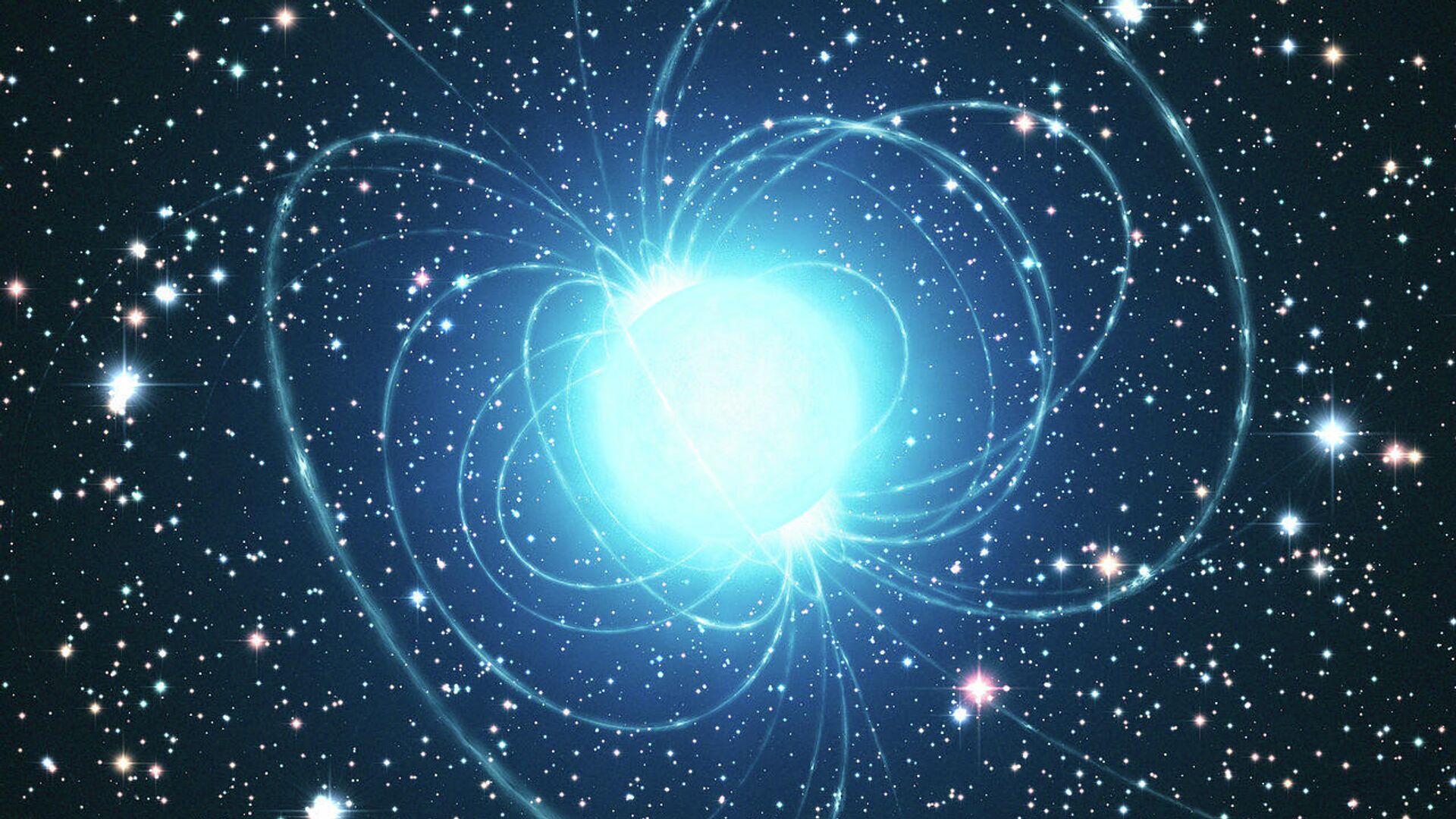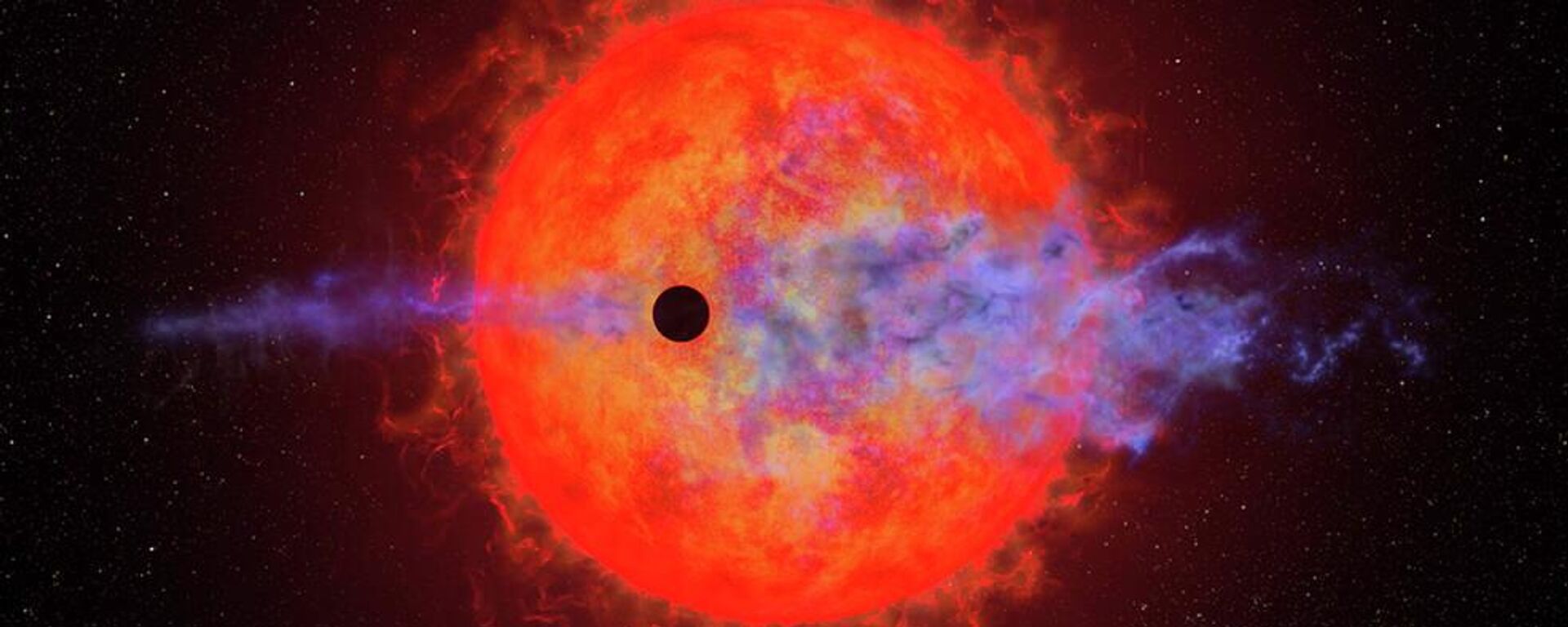https://sputnikglobe.com/20230817/astronomers-spot-large-helium-star-likely-to-become-mysterious-magnetar-1112691416.html
Astronomers Spot Large Helium Star Likely to Become Mysterious Magnetar
Astronomers Spot Large Helium Star Likely to Become Mysterious Magnetar
Sputnik International
The deaths of stars can yield a variety of bizarre results, ranging from dense dwarf stars that last 100 trillion years to fast-spinning pulsars that shoot radio waves out like lighthouses, to black holes.
2023-08-17T21:12+0000
2023-08-17T21:12+0000
2023-08-17T21:11+0000
beyond politics
neutron star
supernova
magnet
astronomy
magnetar
https://cdn1.img.sputnikglobe.com/img/07e6/01/1b/1092554940_0:93:1281:813_1920x0_80_0_0_a3142a3971564a05035ddea2bfa69dae.jpg
A team of astronomers believe they may have found a “missing link” between regular stars and an elusive type of neutron star known as a “magnetar,” about which little is known. The star HD 45166 is about 3,000 light-years from Earth and has existed on star charts for more than a century. However, upon closer inspection, astronomers have found the star is highly magnetic and composed almost entirely of helium, a byproduct of the hydrogen fusion that occurs at the center of most stars and is often left behind when they die."This is also the strongest field ever detected in a massive star that may undergo core collapse and become a neutron star."Neutron stars are the remnant core of what was once a massive star that has since gone supernova, leaving behind a collapsed, ultra-dense core. They are called neutron stars because they are propped up against further collapse by neutron degeneracy pressure, a quantum mechanical force. They tend to be less than 20 miles across, and are thus extremely dense.However, they are short-lived, in celestial terms, with their magnetic fields wearing out after about 10,000 years. Just two dozen magnetars have actually been observed by human scientists.As for how some neutron stars become magnetic and turn into magnetars, Julia Bodensteiner, a member of the discovery team and a research fellow at the European Southern Observatory (ESO), explained: "One possible idea is that the magnetar inherited the magnetic field from the collapsing core of its progenitor, implying that the star was magnetic beforehand. Until now, no magnetic massive stars close to the end of their evolution had been found."However, HD 45166 may have changed that.Shenar explained that massive helium stars are predicted to exist abundantly in our galaxy, but one so large has never been found before. The star’s mass was previously calculated at 4.8 stellar masses, with 1 stellar mass being equal to the sun’s mass."It is this conflict between observation and theory that made me and others increasingly obsessed with HD 45166 and eventually led to the hypothesis that it may be magnetic," he said.Shenar explained that the helium star has a wildly powerful magnetic field of 43,000 gauss; by comparison, the sun’s magnetic field is just 1 gauss. However, that’s still pretty weak for a magnetar, which can have magnetic fields as strong as 100 trillion gauss.The study was published on Thursday in Science Advances.
https://sputnikglobe.com/20230801/hubble-spots-toddler-red-dwarf-star-blasting-away-planets-atmosphere-in-tantrum-1112330414.html
Sputnik International
feedback@sputniknews.com
+74956456601
MIA „Rossiya Segodnya“
2023
News
en_EN
Sputnik International
feedback@sputniknews.com
+74956456601
MIA „Rossiya Segodnya“
Sputnik International
feedback@sputniknews.com
+74956456601
MIA „Rossiya Segodnya“
magnetar; helium star; astronomy; neutron star; southern european observatory
magnetar; helium star; astronomy; neutron star; southern european observatory
Astronomers Spot Large Helium Star Likely to Become Mysterious Magnetar
The deaths of stars can yield a variety of bizarre results, ranging from dense dwarf stars that last 100 trillion years to fast-spinning pulsars that shoot radio waves out like lighthouses, to black holes that tear the fabric of space-time itself. But few are as elusive as the magnetar: the universe’s most powerful magnets.
A team of astronomers believe they may have found a “missing link” between regular stars and an elusive type of neutron star known as a “magnetar,” about which little is known.
The star HD 45166 is about 3,000 light-years from Earth and has existed on star charts for more than a century. However, upon closer inspection, astronomers have found the star is highly magnetic and composed almost entirely of helium, a byproduct of the hydrogen fusion that occurs at the center of most stars and is often left behind when they die.
"This is the first time we have found a magnetic massive helium star," Tomer Shenar, lead author of the discovery and an astronomer at the University of Amsterdam, told a space news outlet.
"This is also the strongest field ever detected in a massive star that may undergo core collapse and become a neutron star."
Neutron stars are the remnant core of what was once a massive star that has since gone supernova, leaving behind a collapsed, ultra-dense core. They are called neutron stars because they are propped up against further collapse by neutron degeneracy pressure, a quantum mechanical force. They tend to be less than 20 miles across, and are thus extremely dense.
Magnetars are the most powerful magnets known to exist.
At a distance of 1,000 kilometers, their magnetic fields are so powerful that electrons cannot bind atoms together and atoms are pulled into long needle-like shapes; at 384,000 kilometers, or half the distance from the Earth to the moon, a magnetar could wipe the information from all credit cards on Earth.
However, they are short-lived, in celestial terms, with their magnetic fields wearing out after about 10,000 years. Just
two dozen magnetars have actually been observed by human scientists.
As for how some neutron stars become magnetic and turn into magnetars, Julia Bodensteiner, a member of the discovery team and a research fellow at the European Southern Observatory (ESO), explained: "One possible idea is that the magnetar inherited the magnetic field from the collapsing core of its progenitor, implying that the star was magnetic beforehand. Until now, no magnetic massive stars close to the end of their evolution had been found."
However, HD 45166 may have changed that.
"Our results suggest that the magnetic star in HD 45166 will, in a few million years, collapse into a magnetar," Shenar said. "This highly magnetic star therefore provides clues as to a possible formation route of these mysterious objects."
Shenar explained that massive helium stars are predicted to exist abundantly in our galaxy, but one so large has never been found before. The star’s mass was
previously calculated at 4.8 stellar masses, with 1 stellar mass being equal to the sun’s mass.
"It is this conflict between observation and theory that made me and others increasingly obsessed with HD 45166 and eventually led to the hypothesis that it may be magnetic," he said.
Shenar explained that the helium star has a wildly powerful magnetic field of 43,000 gauss; by comparison, the sun’s magnetic field is just 1 gauss. However, that’s still pretty weak for a magnetar, which can have magnetic fields as strong as 100 trillion gauss.
The study was
published on Thursday in Science Advances.



